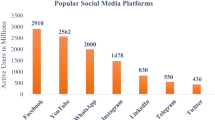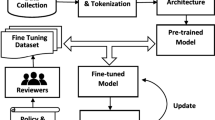Abstract
Usage of mobile phones, access to internet in the fingertips and increasing number of mobile applications has accelerated the generation of online content. Freedom of expression has waived the barriers of online interaction. Curiosity in knowing others viewpoint through their reviews in each and everything starting from a purchase of product to watching a movie has become a common scenario. Decision on success and failure of one’s business is in the hands of public now. Humans are always comfortable, sticking to their native Language, when it comes to expressions whether it is interest, emotions, feeling or opinion. Usage of Natural Language and the trend to analyze the subjective sentiments is increasing day by day. Transliterated text of a language is the English version of spoken native language. For example, Malayalam in English we call as Manglish. Transliterated text has become the language of social media websites like WhatsApp, Facebook, Twitter. It’s a kind of boon to the young generation who know to speak their native language but not to read or write in its own nominal scripts. In this paper we consider the Sentimental Analysis of Transliterated text. RNN-LSTM technique is used to derive the sentiments of transliterated text.







(Courtesy to Madeddu. xyz)


Similar content being viewed by others
Change history
06 June 2022
This article has been retracted. Please see the Retraction Notice for more detail: https://doi.org/10.1007/s12652-022-04045-y
References
Al-Onaizan Y, Knight K (2002) Machine transliteration of names in Arabic text. In: Proceedings of the ACL-02 workshop on computational approaches to semitic languages, pp 1–13
An HW, Moon N (2019) Design of recommendation system for tourist spot using sentiment analysis based on CNN-LSTM. J Ambient Intell Humaniz Comput 1–11
Antony PJ, Soman KP (2011) Machine transliteration for Indian languages: a literature survey. Int J Sci Eng Res 2:1–8
Aramaki E, Imai T, Miyo K, Ohe K (2008) Orthographic disambiguation incorporating transliterated probability. In: Proceedings of the third international joint conference on natural language processing, pp 48–55
Arbabi M, Fischthal SM, Cheng VC, Bart E (1994) Algorithms for Arabic name transliteration. IBM J Res Dev 38(2):183–194
Das A, Ekbal A, Mandal T, Bandyopadhyay S (2009) English to Hindi machine transliteration system at NEWS 2009. In: Proceedings of the 2009 Named Entities Workshop, ACL-IJCNLP 2009. Suntec, Singapore, pp 80–83
Edara DC, Vanukuri LP, Sistla V, Kolli VKK (2019) Sentiment analysis and text categorization of cancer medical records with LSTM. J Ambient Intell Humaniz Comput 1–17
Gupta K, Choudhury M, Bali K (2012) Mining Hindi-English transliteration pairs from online Hindi lyrics. In: LREC, pp 2459–2465
Impana P, Kallimani JS (2017) Cross-lingual sentiment analysis for Indian regional languages. In: 2017 International conference on electrical, electronics, communication, computer, and optimization techniques (ICEECCOT), pp 1–6
Jiang L, Zhou M, Chien LF, Niu C (2007) Named entity translation with web mining and transliteration. In: IJCAI, pp 1629–1634
Jung SY, Hong S, Paek E (2000) An English to Korean transliteration model of extended Markov window. In: Proceedings of the 18th conference on computational linguistics, pp 383–389
Kang BJ, Choi KS (2000) Automatic transliteration and back-transliteration by decision tree learning. In: LREC, pp 1135–1411
Kang IH, Kim G (2000) English-to-Korean transliteration using multiple unbounded overlapping phoneme chunks. In: Proceedings of the 18th conference on computational linguistics, pp 418–424
Karimi S, Turpin A, Scholer F (2006) English to persian transliteration. In: International symposium on string processing and information retrieval, pp 255–266
Karimi S, Scholer F, Turpin A (2011) Machine transliteration survey. ACM Comput Surv (CSUR) 43(3):1–46
Kashani MM, Popowich F, Sarkar A (2007) Automatic transliteration of proper nouns from Arabic to English. In: Proceedings of the second workshop on computational approaches to Arabic script-based languages, pp 275–282
Kumar RG, Shriram R (2019) Sentiment analysis using bi-directional recurrent neural network for Telugu movies. Int J Innov Technol Explor Eng 9(2):241–245
Malik MG (2006) Punjabi machine transliteration. In: Proceedings of the 21st international conference on computational linguistics and the 44th annual meeting of the association for computational linguistics, pp 1137–1144
Malik MGA, Boitet C, Bhattacharyya P (2008) Hindi Urdu machine transliteration using finite-state transducers. In: Proceedings of the 22nd international conference on computational linguistics, pp 537–544
Oh JH, Choi KS (2005) Machine learning based English-to-Korean transliteration using grapheme and phoneme information. IEICE Trans Inf Syst 88(7):1737–1748
Saravanan K, Udupa R, Kumaran A (2010) Crosslingual information retrieval system enhanced with transliteration generation and mining, pp 1–8
Surana H, Singh AK (2008) A more discerning and adaptable multilingual transliteration mechanism for Indian languages. In: Proceedings of the third international joint conference on natural language processing, pp 64–71
Tang D, Qin B, Liu T (2015) Document modeling with gated recurrent neural network for sentiment classification. In: Proceedings of the conference on empirical methods in natural language processing, pp 1422–1432
Wang X, Jiang W, Luo Z (2016) Combination of convolutional and recurrent neural network for sentiment analysis of short texts. In: Proceedings of COLING 2016, the 26th international conference on computational linguistics: technical papers, pp 2428–2437
You JL, Chen YN, Chu M, Soong FK, Wang JL (2008) Identifying language origin of named entity with multiple information sources. IEEE Trans Audio Speech Lang Process 16(6):1077–1086
Author information
Authors and Affiliations
Corresponding author
Additional information
Publisher's Note
Springer Nature remains neutral with regard to jurisdictional claims in published maps and institutional affiliations.
This article has been retracted. Please see the retraction notice for more detail: https://doi.org/10.1007/s12652-022-04045-y
About this article
Cite this article
Thomas, M., Latha, C.A. RETRACTED ARTICLE: Sentimental analysis of transliterated text in Malayalam using recurrent neural networks. J Ambient Intell Human Comput 12, 6773–6780 (2021). https://doi.org/10.1007/s12652-020-02305-3
Received:
Accepted:
Published:
Issue Date:
DOI: https://doi.org/10.1007/s12652-020-02305-3




